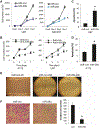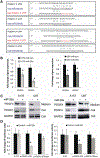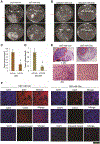MicroRNA-29a inhibits glioblastoma stem cells and tumor growth by regulating the PDGF pathway
- PMID: 31482267
- PMCID: PMC10880555
- DOI: 10.1007/s11060-019-03275-z
MicroRNA-29a inhibits glioblastoma stem cells and tumor growth by regulating the PDGF pathway
Abstract
Background and purpose: microRNAs are small noncoding RNAs that play important roles in cancer regulation. In this study, we investigated the expression, functional effects and mechanisms of action of microRNA-29a (miR-29a) in glioblastoma (GBM).
Methods: miR-29a expression levels in GBM cells, stem cells (GSCs) and human tumors as well as normal astrocytes and normal brain were measured by quantitative PCR. miR-29a targets were uncovered by target prediction algorithms, and verified by immunoblotting and 3' UTR reporter assays. The effects of miR-29a on cell proliferation, death, migration and invasion were assessed with cell counting, Annexin V-PE/7AAD flow cytometry, scratch assay and transwell assay, respectively. Orthotopic xenografts were used to determine the effects of miR-29a on tumor growth.
Results: Mir-29a was downregulated in human GBM specimens, GSCs and GBM cell lines. Exogenous expression of miR-29a inhibited GSC and GBM cell growth and induced apoptosis. miR-29a also inhibited GBM cell migration and invasion. PDGFC and PDGFA were uncovered and validated as direct targets of miR-29a in GBM. miR-29a downregulated PDGFC and PDGFA expressions at the transcriptional and translational levels. PDGFC and PDGFA expressions in GBM tumors, GSCs, and GBM established cell lines were higher than in normal brain and human astrocytes. Mir-29a expression inhibited orthotopic GBM xenograft growth.
Conclusions: miR-29a is a tumor suppressor miRNA in GBM, where it inhibits cancer stem cells and tumor growth by regulating the PDGF pathway.
Keywords: Glioblastoma (GBM); Glioblastoma stem cells (GSC); Platelet-derived growth factor (PDGF); microRNA (miRNA).
Figures





Similar articles
-
Overexpression of miR-29a reduces the oncogenic properties of glioblastoma stem cells by downregulating Quaking gene isoform 6.Oncotarget. 2017 Apr 11;8(15):24949-24963. doi: 10.18632/oncotarget.15327. Oncotarget. 2017. PMID: 28212562 Free PMC article.
-
Mir-370-3p Impairs Glioblastoma Stem-Like Cell Malignancy Regulating a Complex Interplay between HMGA2/HIF1A and the Oncogenic Long Non-Coding RNA (lncRNA) NEAT1.Int J Mol Sci. 2020 May 20;21(10):3610. doi: 10.3390/ijms21103610. Int J Mol Sci. 2020. PMID: 32443824 Free PMC article.
-
MicroRNA-377 inhibited proliferation and invasion of human glioblastoma cells by directly targeting specificity protein 1.Neuro Oncol. 2014 Nov;16(11):1510-22. doi: 10.1093/neuonc/nou111. Epub 2014 Jun 20. Neuro Oncol. 2014. PMID: 24951112 Free PMC article.
-
The emerging role of tumor-suppressive microRNA-218 in targeting glioblastoma stemness.Cancer Lett. 2014 Oct 10;353(1):25-31. doi: 10.1016/j.canlet.2014.07.011. Epub 2014 Jul 17. Cancer Lett. 2014. PMID: 25042866 Review.
-
Unraveling the noncoding RNA landscape in glioblastoma: from pathogenesis to precision therapeutics.Naunyn Schmiedebergs Arch Pharmacol. 2024 Dec;397(12):9475-9502. doi: 10.1007/s00210-024-03265-7. Epub 2024 Jul 15. Naunyn Schmiedebergs Arch Pharmacol. 2024. PMID: 39007929 Review.
Cited by
-
MicroRNA-29a inhibits cell proliferation and arrests cell cycle by modulating p16 methylation in cervical cancer.Oncol Lett. 2021 Apr;21(4):272. doi: 10.3892/ol.2021.12533. Epub 2021 Feb 9. Oncol Lett. 2021. PMID: 33717269 Free PMC article.
-
Role of microRNAs in glioblastoma.Oncotarget. 2021 Aug 17;12(17):1707-1723. doi: 10.18632/oncotarget.28039. eCollection 2021 Aug 17. Oncotarget. 2021. PMID: 34434499 Free PMC article.
-
The role of RNA methylation in glioma progression: mechanisms, diagnostic implications, and therapeutic value.Front Immunol. 2025 May 21;16:1583039. doi: 10.3389/fimmu.2025.1583039. eCollection 2025. Front Immunol. 2025. PMID: 40469294 Free PMC article. Review.
-
miR-29a sensitizes the response of glioma cells to temozolomide by modulating the P53/MDM2 feedback loop.Cell Mol Biol Lett. 2021 May 27;26(1):21. doi: 10.1186/s11658-021-00266-9. Cell Mol Biol Lett. 2021. PMID: 34044759 Free PMC article.
-
Novel cancer gene discovery using a forward genetic screen in RCAS-PDGFB-driven gliomas.Neuro Oncol. 2023 Jan 5;25(1):97-107. doi: 10.1093/neuonc/noac158. Neuro Oncol. 2023. PMID: 35738865 Free PMC article.
References
MeSH terms
Substances
Grants and funding
LinkOut - more resources
Full Text Sources
Medical
Research Materials

